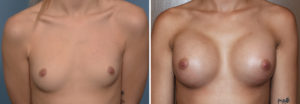Background: The most common patient that seeks breast augmentation is the young female. They understandably seek it because of little breast tissue development in most cases. Their young age and minimal breast tissue growth through their teenage years creates a very pubescent chest appearance. Their small breasts and tight tissue makes them a great candidate for breast augmentation surgery as the good nipple position and tight skin make for a potentially ideal breast mound shape.
But just because not much breast tissue has developed does not mean that what has grown has done so symmetrically. Even small breasts have asymmetry if evaluated carefully. Breast asymmetry in young women is the norm not the exception.
Breast asymmetry, even in small to moderate amounts, is very relevant in breast augmentation surgery as it will impact the aesthetic outcome. The small differences in breast mound skin may become more visible when the breast ind becomes bigger. In some cases, however, implant augmentation may overcome the asymmetry and make the breasts appear more symmetric. Young women need to be aware that any asymmetry they have may or may not improve with breast implants
Case Study: This young female presented for breast augmentation surgery. While she had an A cup breast size her left breast was noticeably smaller. Her shoulder level and posture was also seen to be asymmetry.

The general rule in breast augmentation surgery is that implants merely take the breasts one has and makes them bigger. Thus any asymmetry before surgery will remain after surgery. This is a good rule but is not absolute. In small breasts with good overlying skin the volume created by the implant may overcome small to moderate amounts of natural mound asymmetry. In more significant cases of asymmetry using a larger implant in the smaller breast can be helpful. But in small asymmetries that approach is just as likely to create persistent postoperative asymmetry with the smaller breast now becoming the larger one.
Highlights:
1) Breast asymmetry is very common in young women who seek breast augmentation.
2) Typically breast implants take the differences between the two asymmetric breasts and may make it more visible.
3) In more moderate breast asymmetry it is usually best to use similarly sized silicone implants to avoid the risk of creating the opposite asymmetry problem…overcorrection.
Dr. Barry Eppley
Indianapolis, Indiana



